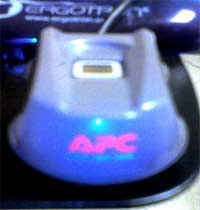Tablets, biometrics disrupting the status quo at your local doctor's office


For starters, every examination room has a sit-down workstation in it. The workstation is an HP-based desktop (standing on its side, model number was indiscernable) with what appears to be a 17" LCD display (pretty big). The systems run Windows XP and they're primarily for the doctors. Unauthorized access to the systems (probably in the name of protecting patient data) is prevented through the use of an fingerprint reader. In this case, it was the APC model seen above right (sorry for the blurriness... it was the best of six pictures I took with the camera in the Motorola Q). I couldn't see a model name but my guess is that it's APC's $50 BIOPOD.
The reason I say these workstations are primarily for the doctors is that everyone else running around this particular practice had an IBM X41 Thinkpad Tablet with them (today, if you want a tablet from Lenovo, your choice is the X60). The tablets however did not have any biometric security associated with them. The explanation was that, as a matter of policy, the tablets never leave the sides of their owners (until they leave the building). As you can see from the picture below, the tablets don't get used in pure tablet format. In other words, the display isn't swiveled and folded down in a way that it covers the keyboard. That's because some of the data that gets entered into the medical application they use requires keyboard input. That application, by the way, appeared to be Logician (now a part of GE Healthcare's Centricity Practice Management lineup) and it's also accessed from the workstations in the examination rooms by the doctors (who don't carry notebooks at their sides). All the systems (desktops and tablets) connect to some central server by way of a Cisco-based Wi-Fi network.